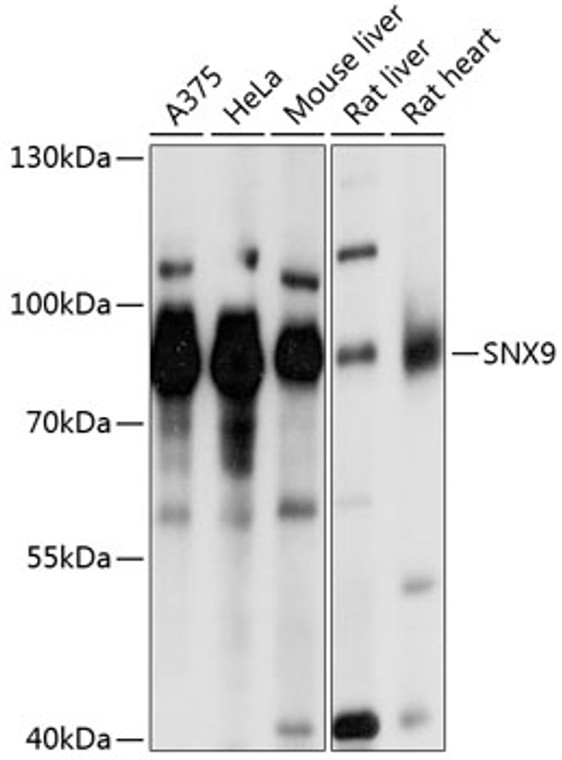| Host: |
Rabbit |
| Applications: |
WB |
| Reactivity: |
Human/Mouse/Rat |
| Note: |
STRICTLY FOR FURTHER SCIENTIFIC RESEARCH USE ONLY (RUO). MUST NOT TO BE USED IN DIAGNOSTIC OR THERAPEUTIC APPLICATIONS. |
| Short Description: |
Rabbit polyclonal antibody anti-SNX9 (1-210) is suitable for use in Western Blot research applications. |
| Clonality: |
Polyclonal |
| Conjugation: |
Unconjugated |
| Isotype: |
IgG |
| Formulation: |
PBS with 0.01% Thimerosal, 50% Glycerol, pH7.3. |
| Purification: |
Affinity purification |
| Dilution Range: |
WB 1:500-1:2000 |
| Storage Instruction: |
Store at-20°C for up to 1 year from the date of receipt, and avoid repeat freeze-thaw cycles. |
| Gene Symbol: |
SNX9 |
| Gene ID: |
51429 |
| Uniprot ID: |
SNX9_HUMAN |
| Immunogen Region: |
1-210 |
| Immunogen: |
Recombinant fusion protein containing a sequence corresponding to amino acids 1-210 of human SNX9 (NP_057308.1). |
| Immunogen Sequence: |
MATKARVMYDFAAEPGNNEL TVNEGEIITITNPDVGGGWL EGRNIKGERGLVPTDYVEIL PSDGKDQFSCGNSVADQAFL DSLSASTAQASSSAASNNHQ VGSGNDPWSAWSASKSGNWE SSEGWGAQPEGAGAQRNTNT PNNWDTAFGHPQAYQGPATG DDDDWDEDWDGPKSSSYFKD SESADAGGAQRGNSRASSSS MKIPLNKFPG |
| Tissue Specificity | Widely expressed, with highest levels in heart and placenta, and lowest levels in thymus and peripheral blood leukocytes. |
| Post Translational Modifications | Ubiquitinated by ITCH. Phosphorylated on tyrosine residues by TNK2. Phosphorylation promotes its activity in the degradation of EGFR. |
| Function | Involved in endocytosis and intracellular vesicle trafficking, both during interphase and at the end of mitosis. Required for efficient progress through mitosis and cytokinesis. Required for normal formation of the cleavage furrow at the end of mitosis. Plays a role in endocytosis via clathrin-coated pits, but also clathrin-independent, actin-dependent fluid-phase endocytosis. Plays a role in macropinocytosis. Promotes internalization of TNFR. Promotes degradation of EGFR after EGF signaling. Stimulates the GTPase activity of DNM1. Promotes DNM1 oligomerization. Promotes activation of the Arp2/3 complex by WASL, and thereby plays a role in the reorganization of the F-actin cytoskeleton. Binds to membranes enriched in phosphatidylinositol 4,5-bisphosphate and promotes membrane tubulation. Has lower affinity for membranes enriched in phosphatidylinositol 3-phosphate. |
| Protein Name | Sorting Nexin-9Sh3 And Px Domain-Containing Protein 1Protein Sdp1Sh3 And Px Domain-Containing Protein 3a |
| Database Links | Reactome: R-HSA-432722Reactome: R-HSA-8856828 |
| Cellular Localisation | Cytoplasmic Vesicle MembranePeripheral Membrane ProteinCytoplasmic SideCell MembraneCytoplasmic VesicleClathrin-Coated VesicleGolgi ApparatusTrans-Golgi NetworkCell ProjectionRuffleCytoplasmLocalized At Sites Of Endocytosis At The Cell MembraneDetected On Newly Formed MacropinosomesTransiently Recruited To Clathrin-Coated Pits At A Late Stage Of Clathrin-Coated Vesicle FormationColocalizes With The Actin Cytoskeleton At The Cell Membrane |
| Alternative Antibody Names | Anti-Sorting Nexin-9 antibodyAnti-Sh3 And Px Domain-Containing Protein 1 antibodyAnti-Protein Sdp1 antibodyAnti-Sh3 And Px Domain-Containing Protein 3a antibodyAnti-SNX9 antibodyAnti-SH3PX1 antibodyAnti-SH3PXD3A antibody |
Information sourced from Uniprot.org
12 months for antibodies. 6 months for ELISA Kits. Please see website T&Cs for further guidance







